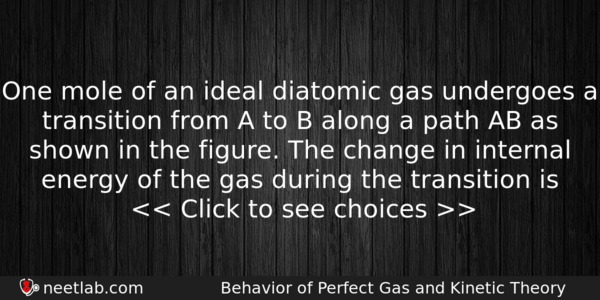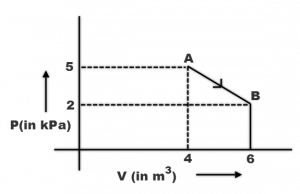| ⇦ | 
| ⇨ |
One mole of an ideal diatomic gas undergoes a transition from A to B along a path AB as shown in the figure.

The change in internal energy of the gas during the transition is
Options
(a) -20 kJ
(b) 20 J
(c) -12 kJ
(d) 20 kJ
Correct Answer:
-20 kJ
Explanation:
No explanation available. Be the first to write the explanation for this question by commenting below.
Related Questions: - The velocity of a particle performing simple harmonic motion, when it passes
- A bullet of mass m moving with velocity v strikes a block of mass M at rests
- In a potentiometer experiment, the balancing with a cell is at length 240 cm.
- A black body is at 727⁰C. It emits energy at a rate which is proportional to
- Two points are located at a distance of 10 m and 15 m from the source of oscillation
Topics: Behavior of Perfect Gas and Kinetic Theory
(34)
Subject: Physics
(2479)
Important MCQs Based on Medical Entrance Examinations To Improve Your NEET Score
- The velocity of a particle performing simple harmonic motion, when it passes
- A bullet of mass m moving with velocity v strikes a block of mass M at rests
- In a potentiometer experiment, the balancing with a cell is at length 240 cm.
- A black body is at 727⁰C. It emits energy at a rate which is proportional to
- Two points are located at a distance of 10 m and 15 m from the source of oscillation
Topics: Behavior of Perfect Gas and Kinetic Theory (34)
Subject: Physics (2479)
Important MCQs Based on Medical Entrance Examinations To Improve Your NEET Score
18000+ students are using NEETLab to improve their score. What about you?
Solve Previous Year MCQs, Mock Tests, Topicwise Practice Tests, Identify Weak Topics, Formula Flash cards and much more is available in NEETLab Android App to improve your NEET score.
Share this page with your friends

ΔU = nCΔT
Also, T = PV/nR
Now,
ΔT = T-T => [PV – PV] / nR
ΔU = nR/¥-1 {PV- PV / nR} [here, ¥ = gamma]
(nR will be cancelled out)
We get,
{-8 x 10^3} / {2/5} = -20kJ.
Hope it helps 🙂